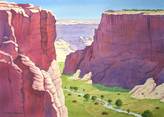Science: Utah Environments
|
Utah has diverse plant and animal life that is adapted to and interacts in areas that can be described as wetlands, forests, and deserts. The characteristics of the wetlands, forests, and deserts influence which plants and animals survive best there. Living and nonliving things in these areas are classified based on physical features. |
Standard 5: Students will understand the physical characteristics of Utah's wetlands, forests, and deserts and identify common organisms for each environment.
Objective 1: Describe the physical characteristics of Utah's wetlands, forests, and deserts.
- Compare the physical characteristics (e.g., precipitation, temperature, and surface terrain) of Utah's wetlands, forests, and deserts.
- Describe Utah’s wetlands (e.g., river, lake, stream, and marsh areas where water is a major feature of the environment) forests (e.g., oak, pine, aspen, juniper areas where trees are a major feature of the environment), and deserts (e.g., areas where the lack of water provided an environment where plants needing little water are a major feature of the environment).
- Locate examples of areas that have characteristics of wetlands, forests, or deserts in Utah.
- Based upon information gathered, classify areas of Utah that are generally identified as wetlands, forests, or deserts. e. Create models of wetlands, forests, and deserts.
Objective 2: Describe the common plants and animals found in Utah environments and how these organisms have adapted to the environment in which they live.
- Identify common plants and animals that inhabit Utah's forests, wetlands, and deserts.
- Cite examples of physical features that allow particular plants and animals to live in specific environments (e.g., duck has webbed feet, cactus has waxy coating).
- Describe some of the interactions between animals and plants of a given environment (e.g., woodpecker eats insects that live on trees of a forest, brine shrimp of the Great Salt Lake eat algae and birds feed on brine shrimp).
- Identify the effect elevation has on types of plants and animals that live in a specific wetland, forest, or desert.
- Find examples of endangered Utah plants and animals and describe steps being taken to protect them.
Objective 3: Use a simple scheme to classify Utah plants and animals.
- Explain how scientists use classification schemes.
- Use a simple classification system to classify unfamiliar Utah plants or animals (e.g., fish/amphibians/reptile/bird/mammal, invertebrate/vertebrate, tree/shrub/grass, deciduous/conifers).
Objective 4: Observe and record the behavior of Utah animals.
- Observe and record the behavior of birds (e.g., caring for young, obtaining food, surviving winter).
- Describe how the behavior and adaptations of Utah mammals help them survive winter (e.g., obtaining food, building homes, hibernation, migration).
- Research and report on the behavior of a species of Utah fish (e.g., feeding on the bottom or surface, time of year and movement of fish to spawn, types of food and how it is obtained).
- Compare the structure and behavior of Utah amphibians and reptiles.
- Use simple classification schemes to sort Utah's common insects and spiders.
Assignments
Resources
Explore BrainPop Interactive Activities:
Utah Environments
Utah Environments
- Deserts
- Ecosystem
- Land Biomes
- Mountains
- Wetlands, complete this worksheet as you play the game


